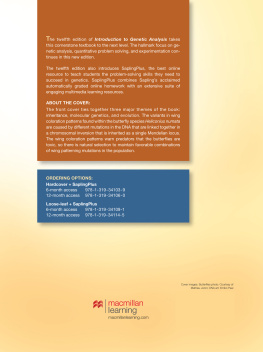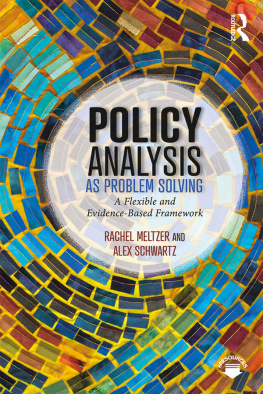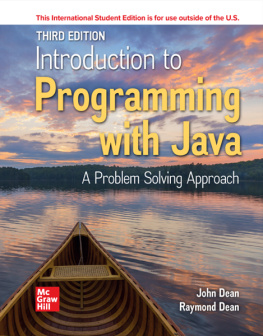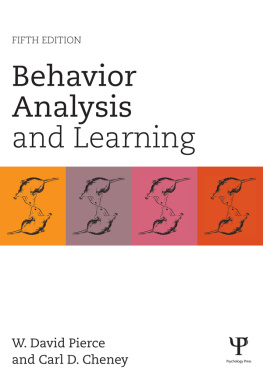Answers to Selected Problems
This section includes selected answers to Basic Problems and Challenging Problems. Answers to all the problems are available in the Solutions Manual.
CHAPTER 1
- Approximately equal proportions of purple and white.
- 4. a. Blue spheres are atoms in the sugar phosphate backbone.
- b. Brown slabs are nucleotide bases.
- Archaea.
- The complementary strand reads CAAGCGCCGGCGCTTG. The two strands are both complementary and palindromic.
- 68 cytosines, 68 guanines, and 32 thymines.
CHAPTER 2
- Ap3 has no petals. Ag has no stamens.
- 651 2/3 = 434
- At meiosis, the replicated homologs are paired. At mitosis, each homolog is by itself.
- One possibility is that a mutation in a non-active site could affect the folding (and thus the function) of the protein.
- Half the males would have red eyes and half would have white eyes. All females would have red eyes. Half of them would be homozygous for the wild-type allele, and half would be heterozygous.
- (1) No.
- (2) No; small sample sizes often do not concur with expected frequencies.
- PARK7, HTT, PAH, EXA, ASPA, PRNP, NF2
- No.
- The male III-2 may have been misdiagnosed, or in his genome the dominant allele may have been suppressed by other genes.
- II-1 must be Tt; III-11 is most likely TT.
- (c) The cross in generation V must have been Aa Aa, so the probability of having five affected children would be = 1/1024. This result could be purely by chance, or there might be another, more subtle, biological reason.
- Gel electrophoresis separates DNA molecules by size. When DNA is carefully isolated from Neurospora (which has seven different chromosomes), seven bands should be produced with the use of this technique. Similarly, the pea has seven different chromosomes and will produce seven bands (homologous chromosomes will comigrate as a single band).
- The key function of mitosis is to generate two daughter cells genetically identical with the original parent cell.
- As cells divide mitotically, each chromosome consists of identical sister chromatids that are separated to form genetically identical daughter cells. Although the second division of meiosis appears to be a similar process, the sister chromatids are likely to be different from each other. Recombination in earlier meiotic stages will have swapped regions of DNA between sister and nonsister chromosomes such that the two daughter cells of this division are typically not genetically identical.
- Yes. Half of our genetic makeup is derived from each parent, half of each parents genetic makeup is derived from half of each of their parents, etc.
- (5) Chromosome pairing.
- The progeny ratio is approximately 3:1, indicating classic heterozygous-by-heterozygous mating. Because Black (B) is dominant over white (b),
| Parents: | B/bB/b |
| Progeny: | 3 black : 1 white (1 B/B : 2 B/b : 1 b/b) |
- The fact that about half of the F1 progeny are mutant suggests that the mutation that results in three cotyledons is dominant and the original mutant was heterozygous. If C = the mutant allele and c = the wild-type allele, the cross is as follows:
| P | C/cc/c |
| F1 | C/c three cotyledons
c/c two cotyledons |
- p (child has galactosemia) = p (John is G/g) p (Martha is G/g) p (both parents passed g to the child) = (2/3)(1/4)(1/4) = 2/48 = 1/24
- 62. a. The disorder appears to be dominant because all affected individuals have an affected parent. If the trait were recessive, then I-1, II-2, III-1, and III-8 would all have to be carriers (heterozygous for the rare allele).
- b. With the assumption of dominance, the genotypes are
| I. | d/d, D/d |
| II. | D/d, d/d,D/d, d/d |
| III. | d/d, D/d, d/d, D/d, d/d, d/d, D/d, d/d |
| IV. | D/d, d/d, D/d, d/d, d/d, d/d, d/d, D/d, d/d |
- c. The probability of an affected child (D/d) equals 1/2, and the probability of an unaffected child (d/d) equals 1/2. Therefore, the chance of having four unaffected children (since each is an independent event) is (1/2) (1/2) (1/2) (1/2) = 1/16.
- 68. a. Sons inherit the X chromosome from their mothers. The mother has free earlobes; the son has attached earlobes. If the allele for free earlobes is dominant and the allele for attached earlobes is recessive, then the mother could be heterozygous for this trait and the gene could be X linked.
- b. It is not possible from the data given to decide which allele is dominant. If attached earlobes is dominant, then the father would be heterozygous and the son would have a 50% chance of inheriting the dominant attached earlobes allele. If attached earlobes is recessive, then the trait could be autosomal or X linked, but, in either case, the mother would be heterozygous.
- Let H = hypophosphatemia and h = normal. The cross is H/Y h/h, yielding Hh (females) and h/Y (males). The answer is 0%.
- 77. a.XC/Xc, Xc/Xc
- b.p(color-blind) p(male) = (1/2)(1/2) = 1/4
- c. The girls will be 1 normal (XC/Xc) : 1 color-blind (Xc/Xc).
- d. The cross is XC/Xc Xc/Y, yielding 1 normal:1 color-blind for both sexes.
- 85. a. The pedigree suggests that the allele causing red hair is recessive because most red-haired individuals are from parents without this trait.
- b. Observation of those around us makes the allele appear to be somewhat rare.
- Note that only males are affected and that, in all but one case, the trait can be traced through the female side. However, there is one example of an affected male having affected sons. If the trait is X linked, this males wife must be a carrier. Depending on how rare this trait is in the general population, that could be unlikely, suggesting that the disorder is caused by an autosomal dominant allele with expression limited to males.
CHAPTER 3
- 1. a. 0.05
- b. 0.01
- c.p values decrease as df decreases.
- Anaphase I.
- AAaa.
- No, because all progeny would be one phenotype.
- Left hand parent, right hand parent, and tester.
- Trihybrid selfs have fully recessive progeny, which = 1/64.
- Some green, some white, some variegated.
- Affected fathers do not transmit the disease.
- The genotype of the daughter cells will be identical with that of the original cell: (f) A/a ; B/b.
- Mitosis produces daughter cells having the same genotype as that of the original cell: A/a ; B/b ; C/c.
- His children will have to inherit the satellite-containing 4 (probability = 1/2), the abnormally staining 7 (probability = 1/2), and the Y chromosome (probability = 1/2). To inherit all three, the probability is (1/2)(1/2)(1/2) = 1/8.








